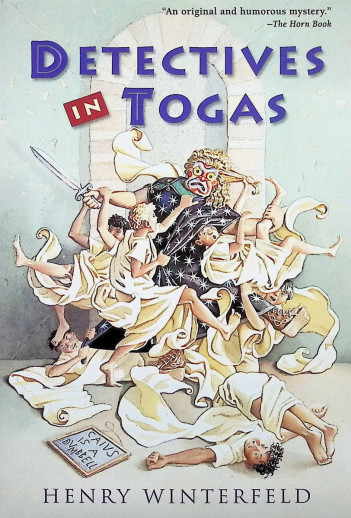We use cookies to make your experience better. To comply with the new e-Privacy directive, we need to ask for your consent to set the cookies. Learn more.
Detectives in Togas
This fictitious tale is set in Ancient Rome. Caius, Rufus, Antonius, Mucius, Flavius, Julius, and Publius are students in the finest grammar school in all of Rome. Only wealthy patricians can afford to send their sons to this school, so these seven are the entire class. One day Cauis begins to irritate Rufus, and Rufus retaliates by writing "Cauis is a dumbbell" on his writing tablet and hanging it up at the front of the classroom. This leads to a scuffle, which their teacher soon dissolves. Rufus is sent home, and the boys are subdued. The next day arrives with a string of mysteries. Neither Rufus nor Cauis come to school, but an even bigger problem is that the teacher isn't there! This has never happened before. The remaining students find him tied up in his closet, his house ransacked. It appears that the burglar took only some mathematic books, unimportant pictures, and Rufus's writing tablet. When the boys go to visit Rufus, they find the words "Cauis is a dumbbell" written in red paint on the temple wall. Rufus claims he is innocent and his handwriting was forged, but his classmates discover that he was out all night long, with no good alibi. Now Rufus has been arrested, and it's up to his six friends to find out who is behind all the mysteries before Rufus is punished for desecrating the temple!
Instead of isolating Bible and Christian history from what was happening in the rest of the world, the folks at Veritas aim to incorporate it. They offer four different history time periods (each aimed at a different grade level and designed to take one school year) which take students from creation to the present. The program originally had three parts: teacher's manual, history cards (an absolutely essential element of the curriculum) and a memory song on audio CD. The song is sung by a woman with a pleasant voice at varying tempos and is designed as a type of auditory time line.
The history cards are fantastic! They have many interesting facets (the more you study them, the more you learn). The cards from the various time periods are color coded and numbered - there are 32 cards in each pack. If the cards also relate to Bible history they have another color and another number. Each card has a picture (usually in full color) representing what it is about. For example, the card for Creation has a reproduction of the Creation of the sun and moon from the Sistine Chapel Ceiling by Michelangelo. Many of the other pictures on the other cards are famous paintings as well. Each card has a title and a Scripture reference (if appropriate). They also contain a summary of the event they represent and a list of resources. This information can only be found on the cards and is not duplicated in the Teacher Manual. On the Creation card, examples of the resources are: Child's Story Bible, pages 3, 4 and Streams of Civ, Vol 1, pages 11-14. Reading whatever is set out on the cards provides the ‘text'.
The Teacher Manual is split into 32 weekly lessons. Each lesson has a worksheet, a project or two, and a test. An example of what you might find in the appendix is a literature unit, an Egyptian decor bulletin board pattern, an Egyptian Feast project, reproducible sheets, great games, and lyrics for the memory song. An enhanced CD-ROM is also available, which includes the memory song for that level, an electronic version of the Teacher Manual, and an instructional video. The enhanced CD will work on either Windows or Macintosh. Because the enhanced CD contains the complete Teacher's Manual, we sell two kits; one which includes the Teacher Manual book, the card set, and the audio CD (Homeschool Kit), and one which includes only the enhanced CD and the cards (Homeschool Kit w/ CD). ~ Genevieve
| Product Format: | Softcover Book |
|---|---|
| Brand: | Harcourt, Brace and Company |
| Author: | Winterfield |
| Grades: | 3-6 |
| ISBN: | 9780152162801 |
| Length in Inches: | 7.665 |
| Width in Inches: | 5.119 |
| Height in Inches: | 0.716 |
| Weight in Pounds: | 0.5 |

